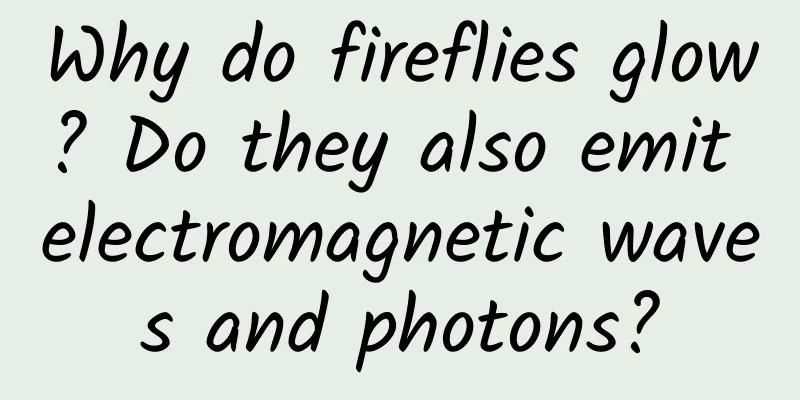Why do fireflies glow? Do they also emit electromagnetic waves and photons?

|
The world is full of wonders, and creatures are even more bizarre. Many animals and plants can glow, and the most common of them are fireflies. Every summer night, they flash in the jungle or fields like little angels, arousing people's endless imagination. Today, let us understand the luminescence mechanism of this small animal from the perspectives of biology, chemistry and physics. 1. The luminescence mechanism of fireflies Simply put, the luminescence of fireflies is a complex biochemical reaction catalyzed by luciferin, during which energy is released in the form of light. In other words, the light of fireflies, like all light sources in the world, is the release of energy. There are more than 2,000 species of fireflies. Different species have different forms of light emission and the colors of light are also different. There are yellow, orange, red, yellow-green, green and other colors of fluorescence. I won’t go into details today. Specifically, the glowing part of a firefly is a light organ in its abdomen, which is composed of light-emitting cells, reflective layer cells, nerves and epidermal cells. The structure of the light organ is a bit like the headlight assembly of a car. The light-emitting cells are the bulbs, and the reflective layer cells are like the reflectors and lampshades of the car lights, which reflect the light emitted by the bulbs. Luminescent cells contain two types of chemicals, one is called luciferin and the other is called luciferase. Under the catalysis of luciferase, luciferin will react chemically with oxygen in the air and release energy, mainly in the form of fluorescence. Therefore, the luminescence of fireflies is a biochemical reaction. Why do fireflies flash? This is because fireflies breathe, and the oxygen transported in their trachea is uneven. When there is enough oxygen, the chemical reaction in the luminous cells is strong and the brightness is high; otherwise, the reaction is slow, the light becomes weak, or even dim. There is also a chemical called adenosine triphosphate (ATP) in the body of fireflies, which can regulate the luminescent function of luciferin and emit light again when the fluorescence becomes weak. The purpose of firefly light is to illuminate the fireflies for food, to intimidate and defend against enemies, and more importantly, to communicate information for courtship. Adult fireflies will look for mates at night by emitting different lights. Male fireflies generally emit light for 0.2 seconds and at intervals of 2.2 seconds; female fireflies respond 0.5 seconds after male fireflies emit light. 2. Do fireflies also emit photons? Of course, all light in this world is electromagnetic waves, and is transmitted by photons. So how many photons can a firefly emit? This starts with the wavelength of visible light. Visible light is composed of about 7 colors, with wavelengths between 380 and 760 nm (nanometers). Different colors have different wavelengths, with red light having the longest wavelength and violet light having the shortest wavelength. The light emitted by fireflies has multiple colors or gradient colors such as green, yellow, orange, and red, and the wavelength band from green to red is between 492 and 760 nm. We compromised and took the average wavelength of 626nm, so that we can roughly calculate the number of photons emitted by fireflies. First, we need to calculate the energy of 626nm photons, using the formula: E=hc/λ. Here, E represents energy; h represents Planck's constant, which is about 6.626*10^-34J·s; and λ is the wavelength of the photon. In this way, we can calculate that each photon with a wavelength of 626nm has an energy of about 3.17*10^-19J (joules). So how many such photons can a firefly emit per second? This depends on how bright the firefly is. After searching for a long time, I couldn't find any data specifically studying the brightness of fireflies. I only found one study that believed that 1,000 fireflies were equivalent to the brightness of a 20-watt light bulb. The luminous efficiency of different types of electric lamps is different, that is, the efficiency of converting electric lamp energy into photons is different. Incandescent lamps have the smallest luminous efficiency, with luminous efficiency accounting for only 15% of their energy, and most of the rest of the energy is converted into heat energy. In comparison, the efficiency of fluorescent lamps can reach 50%, and the efficiency of LED energy-saving lamps can reach 90%. The study did not say that the light emitted by these 1,000 fireflies is equivalent to that of a 20-watt light bulb, but generally speaking, the only comparison with a light bulb is incandescent light bulbs. According to incandescent light bulbs, the light efficiency of a 20-watt light bulb is only 15%, which is about 3 watts, and the photon energy emitted per second is 3J. In this way, the number of photons with a wavelength of 626nm released per second is about 9.5*10^18. Divided by 1,000 fireflies, each firefly releases about 9.5*10^15 photons per second, which is 950 trillion. That's a lot, no wonder the fireflies we see are so bright. Some studies believe that the luminous efficiency of fireflies is very high, reaching 88-90%, and some say as high as 95%, so very little energy is converted into heat, and they are recognized as cold light sources. Today's LED luminous efficiency has reached 90%, which is similar to that of fireflies, so it should also be classified as a cold light source. 3. The inspiration that the cold light source mechanism of fireflies brings to mankind The luminescence principle of cold light sources is that under the action of an electric field, the generated electrons collide and excite the fluorescent material to produce luminescence, which has excellent optical properties and high luminescence efficiency. Generally speaking, cold light sources generate little or no heat when working. The luminous properties of fireflies have brought many inspirations to mankind. People have successfully extracted luciferin and luciferase from the fireflies' light organs, understood their composition through analysis, and then successfully prepared these substances through chemical synthesis methods. They were applied to light-emitting devices, greatly improving the luminous efficiency. For example, fluorescent lamps, neon lights, LCD screens, LEDs, etc., are all cold light sources invented thanks to the inspiration of fireflies. Of course, cold light sources do not generate no heat at all, but the luminous efficiency is greatly improved. For example, fluorescent lamps are 35% higher than incandescent lamps, while LEDs are 75% higher. However, some people believe that the luminous efficiency of fireflies is not as high as previously thought. A research team led by Professor Hideo Akiyama of the University of Tokyo in Japan measured the brightest North American fireflies and found that when they glow at their highest intensity, the light intensity is only 41% of the energy that the luminescent substances in their bodies can emit, which is not even as efficient as fluorescent lamps. But fluorescent lamps still have temperature, because part of the energy is converted into heat. If fireflies only use 41% of the total energy to emit light, but they do not generate heat, what is the excess energy converted into? It seems that further research is needed, and more evidence is needed. In the animal and plant world, there are many luminous creatures. For example, there is a kind of deep-sea anglerfish in the ocean, which has a glowing "little lantern" on its head; there is a kind of "moon fish" that can also glow, and some jellyfish can also glow; there are also some luminous plants, such as "lamp grass", "ghost tree" and so on. Some of these animals and plants can glow, just like fireflies, with luciferin and luciferase in their body structure, while others have some special proteins in their bodies. For example, in the body of the luminous jellyfish there is a protein called equiline, which emits light when combined with calcium ions. Nature has spent billions of years carving animals and plants into extremely fine and perfect forms, and the mechanisms involved are extremely complex. Even with the development of human technology, human beings have not yet imitated nature to a fraction of its original state. A very important discipline that has developed in modern times is called bionics, which is about understanding the various mechanisms of the animal and plant world to create more exquisite tools or food. By learning and understanding the luminescence mechanism of animals and plants such as fireflies, future light energy technology will become more and more advanced. That’s all for today. Welcome to discuss and thank you for reading. The copyright of Space-Time Communication is original. Infringement and plagiarism are unethical behavior. Please understand and cooperate. |
>>: DIKW Pyramid, which level has AI climbed to?
Recommend
Full of contrasts! The post-90s "blonde doctoral supervisor" who became popular with fashion won a million-dollar award!
What is your impression of a doctoral supervisor?...
The world's first mass-produced solar car has turned yellow? Maybe it never existed...
The world's first solar car went bankrupt jus...
Competitive product analysis report: Bilibili VS A-station & TikTok
This article is a competitive product analysis re...
Practical Tips | Shopping Routes: A Concept That Operators Must Know
Over the years that I have been engaged in e-comm...
Spring sleepiness is not a disease, but it is really painful when you feel sleepy.
After a long and cold winter, we finally welcomed...
Even the commentary has to take care of LeTV Sports' comprehensive penetration into the e-sports circle
LeTV Sports is about to break into the e-sports c...
Are you still afraid of chickens in your 30s? This is not hypocrisy
Audit expert: Yin Tielun Deputy Chief Physician, ...
How much does it cost to customize a cosmetics mini app in Weifang?
The launch of mini programs has brought convenien...
7 kinds of "delicious" foods that make you more "tired" the more you eat them! Experts teach you how to eat away "fatigue" one bite at a time!
"Spring is sleepy, autumn is tired, summer i...
Low-profile phones can also use native, "light version" system Android Go is here | JuTou
At the Google I/O Developer Conference in May thi...
What are the benefits of precision and accuracy in activities from the perspective of activity costs?
Today, Strawberry would like to talk to you about...
As a mobile fitness app, what is Keep’s financial approach?
Not long ago, I saw an article about a red envelo...
Are carbon plate shoes reliable for speed increase? In short, teenagers should wear less
In the pursuit of sports performance, carbon plat...
It turns out that China has long been a "infrastructure maniac" - revealing the secrets of Baoxiadao
In "The Road to Shu", Li Bai used magni...
Apple iOS 15 officially released: new notification interface and FaceTime, big improvements to weather, photos, and wallet
June 8 news: Early this morning, Apple held the W...









